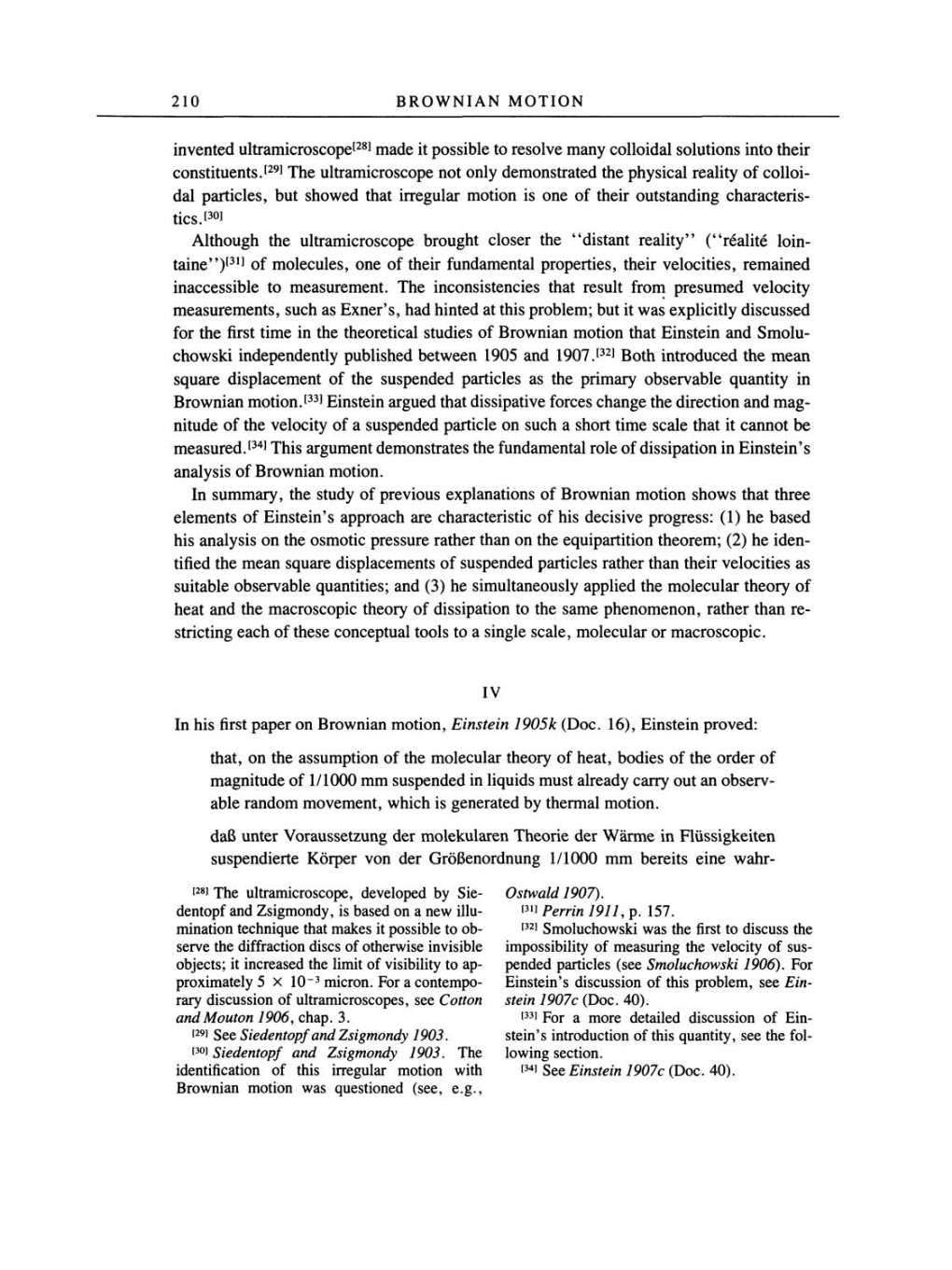210
BROWNIAN MOTION
invented
ultramicroscope[28]
made it
possible
to resolve
many
colloidal solutions into
their
constituents.[29] The
ultramicroscope
not
only
demonstrated the
physical reality
of
colloi-
dal
particles,
but showed that
irregular
motion
is
one
of
their
outstanding
characteris-
tics.[30]
Although
the
ultramicroscope
brought
closer the
"distant
reality" ("realite loin-
taine")[31]
of
molecules,
one
of
their fundamental
properties,
their velocities,
remained
inaccessible to measurement. The inconsistencies that result from
presumed
velocity
measurements,
such
as
Exner's, had hinted
at this
problem;
but it
was
explicitly
discussed
for the
first time in the
theoretical studies
of
Brownian motion
that Einstein and Smolu-
chowski
independently published
between 1905 and
1907.[32]
Both introduced
the
mean
square
displacement
of
the
suspended particles as
the
primary
observable
quantity
in
Brownian
motion.[33]
Einstein
argued
that
dissipative
forces
change
the direction and
mag-
nitude
of
the
velocity
of
a suspended particle on
such
a
short time scale that it cannot be
measured.[34] This
argument
demonstrates the fundamental role
of
dissipation
in
Einstein's
analysis
of
Brownian motion.
In
summary,
the
study
of
previous explanations
of
Brownian motion shows
that
three
elements
of Einstein's
approach are
characteristic
of
his decisive
progress: (1)
he
based
his
analysis on
the osmotic
pressure
rather than
on
the
equipartition
theorem;
(2)
he iden-
tified the
mean square displacements
of
suspended particles
rather than
their
velocities
as
suitable observable
quantities;
and
(3)
he
simultaneously applied
the
molecular
theory
of
heat and the
macroscopic theory
of
dissipation
to
the
same
phenomenon,
rather
than
re-
stricting
each
of
these
conceptual
tools to
a single
scale,
molecular
or
macroscopic.
IV
In his first paper
on
Brownian
motion,
Einstein 1905k
(Doc. 16),
Einstein
proved:
that,
on
the
assumption
of
the molecular
theory
of
heat,
bodies
of
the
order of
magnitude
of
1/1000
mm suspended
in
liquids
must
already carry
out
an
observ-
able random
movement,
which
is
generated by
thermal motion.
daß
unter
Voraussetzung
der molekularen
Theorie
der Wärme in
Flüssigkeiten
suspendierte Körper von
der
Größenordnung
1/1000
mm
bereits eine wahr–
[28]
The
ultramicroscope, developed by
Sie-
dentopf
and
Zsigmondy,
is based
on a new
illu-
mination
technique
that makes it
possible
to ob-
serve
the diffraction discs
of
otherwise invisible
objects;
it increased the limit
of
visibility
to
ap-
proximately
5
x 10-3 micron. For
a contempo-
rary
discussion
of
ultramicroscopes,
see
Cotton
and
Mouton
1906, chap.
3.
[29]
See
Siedentopf
and
Zsigmondy
1903.
[30]
Siedentopf
and
Zsigmondy
1903. The
identification
of
this
irregular
motion with
Brownian motion
was questioned (see,
e.g.,
Ostwald
1907).
[31]
Perrin
1911,
p.
157.
[32]
Smoluchowski
was
the first to discuss the
impossibility
of
measuring
the
velocity
of
sus-
pended particles (see
Smoluchowski
1906).
For
Einstein's
discussion
of
this
problem,
see
Ein-
stein
1907c
(Doc. 40).
[33]
For
a
more
detailed discussion
of
Ein-
stein's
introduction
of
this
quantity,
see
the fol-
lowing
section.
[34]
See
Einstein
1907c
(Doc. 40).
